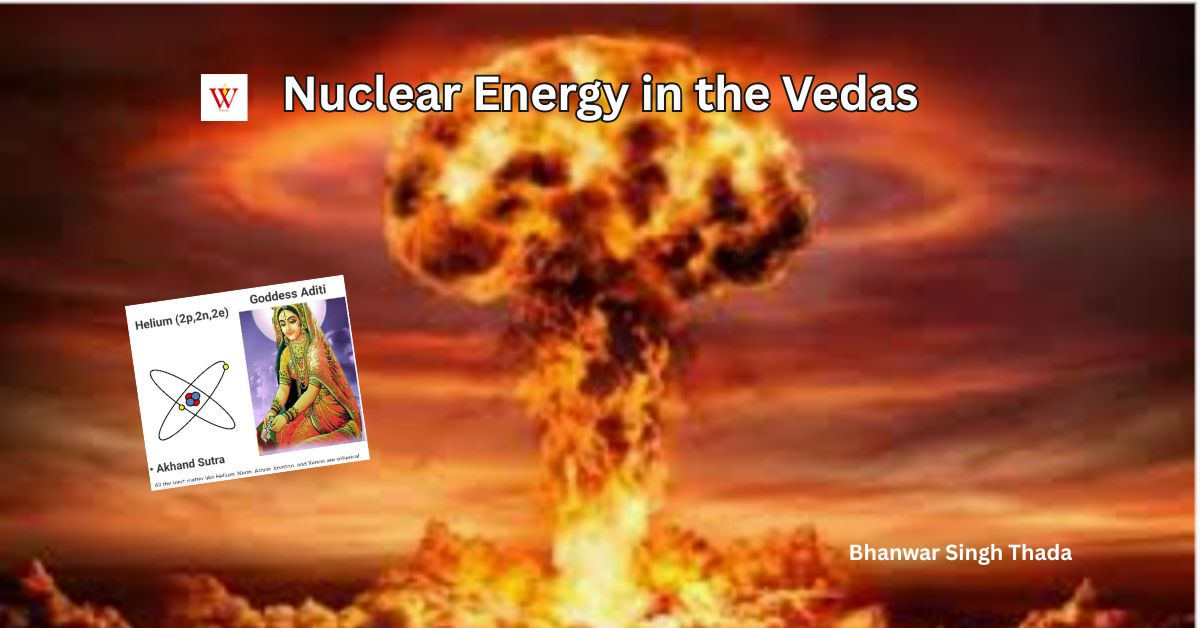For centuries, ancient Indian scriptures, particularly the Vedas, have fascinated scholars and spiritual seekers alike. In recent decades, a new wave of researchers and enthusiasts have claimed that these ancient texts contain references to advanced scientific concepts-including nuclear energy. But how credible are these claims? Is there any textual or historical evidence supporting the idea that the Vedas described nuclear power? Or is it all symbolic and metaphorical?
In this article, we will explore the origins of these claims, analyze relevant verses from the Vedas, and review scientific and scholarly opinions on the subject.
What Are the Vedas?
The Vedas are among the oldest religious texts in the world, believed to have been composed between 1500 BCE and 500 BCE. There are four main Vedas: Rigveda, Yajurveda, Samaveda, and Atharvaveda. They contain hymns, rituals, spiritual philosophy, and metaphysical ideas. Written in Vedic Sanskrit, these texts are revered in Sanatan Dharma (Hinduism) as divinely revealed knowledge.
The Origin of the Nuclear Energy Claim
Claims about nuclear technology in the Vedas began to surface more prominently in the 20th century, especially after the development of nuclear weapons during World War II. Several Indian thinkers and authors, inspired by the power of ancient texts and a sense of national pride, began to interpret certain Vedic and Itihasa (epic) verses as evidence of advanced technology.
Some often-cited sources include:
- The Brahmastra in the Mahabharata, a weapon that is described as emitting intense light and heat.
- Verses from the Rigveda and Atharvaveda, which mention fire, sun, and cosmic energies.
- Puranic accounts of devas (gods) wielding weapons that could destroy entire cities.
Vedic Verses Commonly Referenced
Here are some Sanskrit verses often quoted by proponents of the nuclear energy theory:
1. Rigveda 10.89.1
“O Agni, shine with thy resplendent light, consuming the foes with thy burning flame…”
Interpretation: While this may sound like a description of destructive fire, it is typically understood as a symbolic invocation of divine fire (Agni) in rituals.
2. Atharvaveda 20.41.1
“Let the fire of the sun burn our enemies. Let the blazing flame bring victory to us.”
Interpretation: Again, often interpreted symbolically in the context of war and divine support.
3. Mahabharata (Drona Parva)
“A single projectile charged with all the power of the universe… An incandescent column of smoke and flame, as bright as ten thousand suns…”
Interpretation: This is often cited as a description of a nuclear explosion, but most scholars view it as poetic hyperbole.
Symbolism vs. Literal Interpretation
The primary debate around these texts is whether the descriptions should be taken literally or symbolically.
- Symbolic Interpretation: Many scholars and Sanskritists argue that Vedic descriptions use metaphorical language to explain cosmic and psychological principles. The intense fire or “weapon of the gods” could represent spiritual power, inner transformation, or divine intervention.
- Literal Interpretation: Others argue that ancient sages had intuitive knowledge or higher consciousness, enabling them to access insights about atomic energy, perhaps through deep meditation or yogic vision.
Scientific Viewpoint
Modern scientists, especially those trained in physics or nuclear technology, remain skeptical about the idea that ancient India had actual nuclear weapons or reactors. There is no archaeological evidence supporting the existence of advanced technological devices in Vedic times.
However, some scientists like Dr. Raja Ramanna, who was involved in India’s nuclear program, have acknowledged the remarkable nature of descriptions in texts like the Mahabharata. Still, he clarified that these should not be considered technical blueprints but rather powerful metaphors.
Ancient Indian Science: A Legacy of Knowledge
While literal nuclear energy references are questionable, ancient Indian knowledge in fields like astronomy, mathematics, metallurgy, and medicine is well-documented:
- Sushruta Samhita: Early text on surgery and human anatomy.
- Aryabhata & Bhaskara: Developed advanced astronomical and mathematical models.
- Iron Pillar of Delhi: A metallurgical marvel that has resisted corrosion for over a millennium.
These examples show that India had a rich scientific tradition. But equating poetic descriptions in Vedic texts with nuclear science requires a leap in logic.
The Role of Nationalism and Cultural Revivalism
Post-independence India saw a surge in interest in ancient texts as part of a larger cultural revival. Leaders and thinkers sought to reclaim India’s heritage and assert its intellectual contributions to the world. This led to both serious research and exaggerated claims. It’s important to distinguish between the two.
Scholarly Consensus
The consensus among Sanskrit scholars and historians is that:
- The Vedas contain deep spiritual and philosophical truths.
- Descriptions of weapons or cosmic events are likely metaphorical.
- There is no empirical or archaeological proof of nuclear technology in Vedic times.
This doesn’t diminish the value of the Vedas but places them in their rightful context—as spiritual and cultural texts, not scientific manuals.
Conclusion: Fact or Fiction?
So, is nuclear energy in the Vedas fact or fiction?
The answer lies in perspective. If one seeks metaphorical or philosophical truths, the Vedas offer profound insights into energy, transformation, and the cosmos. If one looks for literal evidence of nuclear technology, the case remains unproven.
Respecting ancient wisdom while applying modern critical thinking is the balanced path forward. The Vedas continue to inspire scientists, philosophers, and seekers-but not necessarily as nuclear physicists in disguise.
FAQs
Q. Did ancient India really have nuclear weapons?
A. No archaeological evidence supports this. Descriptions are symbolic, not technical.
Q. Why do some people believe the Vedas mention nuclear energy?
A. Due to poetic descriptions of powerful weapons and cosmic events, interpreted literally.
Q. Can ancient texts predict future science?
A. Some believe intuitive insights in meditation can hint at scientific truths, but this is speculative.
Q. What is the significance of the Brahmastra?
A. It is a mythological weapon, often likened to nuclear power in its destructive force, but part of epic literature, not historical evidence.
Read Also –
